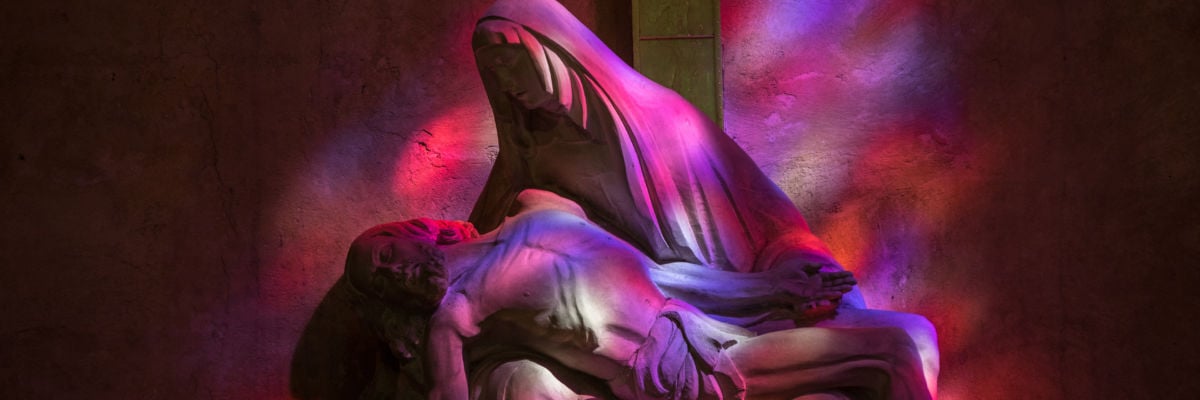
It’s been said that when humans want to communicate an idea, they use words, but God is all-powerful, so he can send a message through the events that happen in history itself. One way he can do that is by foreshadowing his future salvific activity or revealing himself in ways that recall his past salvific activity. This is a fundamental part of biblical interpretation we call typology.
For example, the first letter of St. Peter says the flood that wiped away evil in the world was a type of baptism. Just as Noah and the occupants of the ark were saved through water, so too we are saved through baptism (3:21). Likewise, the crossing of the Red Sea is a type of baptism: it prefigures how we pass through water to be saved, just as Israel passed through water to be saved.
These types can be seen for Christ, for the Church, and for Mary.
I do want to caution that sometimes typology can be overstated and turned into an “irrefutable proof” for certain doctrines. Typology shouldn’t be used that way, but it can be helpful in making doctrines more intelligible to us. For example, consider the typological claim that Mary is the new Ark of the Covenant.
The old Ark of the Covenant carried the word of God written on stone tablets, or the Ten Commandments, inside it. Mary carried the Word become flesh within her body. A cloud often overshadowed the tabernacle where the Ark of the Covenant was kept, and the archangel Gabriel said the Holy Spirit would overshadow Mary when she conceived Jesus (Luke 1:35). When the ark was brought to David, he said, “How can the ark of the Lord come to me?” When Mary visited Elizabeth, she said, “Why is this granted me, that the mother of my Lord should come to me?” (Luke 1:43). 2 Samuel 6:16 records how David leapt in the presence of the ark, and Luke 1:41 describes how John the Baptist leapt in the presence of a pregnant Mary. Finally, the Ark of the Covenant remained in the house of Obed-edom the Gittite for three months, and Mary stayed with Elizabeth for three months.
In an online video, Protestant apologist Mike Winger offers some objections to this analysis.
First, he claims that the verb episkiazo (which means “overshadow”) has no special connection to the Ark of the Covenant in the Old Testament. Second, he says there can’t be a typological connection because there are noticeable differences between the episodes involving the ark in the Old Testament and Mary in the New Testament. For example, David sent the ark away because he feared it, whereas Elizabeth joyfully welcomed Mary.
When it comes to episkiazo, Mike is simply wrong about its use in the Old Testament and its connections to the New Testament. Episkiazo is clearly used of the cloud that overshadows the tabernacle. Protestant scholar Michael Bird says of Luke 1:35 in his 2020 book Evangelical Theology: “The verb episkiazo is ordinarily translated ‘overshadow’ and means to interpose something like casting a shadow. The image is reminiscent of how the glory of God ‘settled’ on the tabernacle in Moses’ day” (Exod. 40:35; the LXX uses episkiazo). Southern Baptist scholar A.T. Robertson says this of the word’s use in Luke 1:35:
A figure of a cloud coming upon her. Common in ancient Greek in the sense of obscuring and with accusative as of Peter’s shadow in Acts 5:15. But we have seen it used of the shining bright cloud at the transfiguration of Jesus. Here it is like the Shekinah glory which suggests it (Exod. 40:38) where the cloud of glory represent the presence and power of God. (Word Pictures in the New Testament, Vol. 2 page 30)
Mike’s second objection is common among Protestant biblical scholars. Darrel Bock is another, who, in his recent two-volume commentary on Luke, says identifying Mary as the new ark is “too subtle, in that the ark for David was a cause for fear, not joy, since that ark was an instrument of God’s judgement.”
However, typological parallels sometimes subvert what happened in the Old Testament as part of their fulfillment. For example, we call Christ the new Adam because he was created without original sin just like the old Adam, but unlike the old Adam, Christ perfectly obeyed the Father. Likewise, Mary is the new Ark of the Covenant, given the proper welcome and respect the old ark did not receive in 2 Samuel.
In fact, the Protestant Word Biblical Commentary writes, “Echoes of 2 Samuel 6:2-19 are to be found in verses 41,43,44, and possibly 56. . . . If the last be granted (v 56) [“Mary stayed with Elizabeth for three months”], then we must go further and say that this taking up of paradigmatic responses has been artistically carried through by treating the presence of Mary (or the unborn Jesus) as equivalent to the presence of the ark of the covenant” (74).
If you’d like to hear more of my thoughts on Mike Winger’s case against Marian typology, check out this episode of the Counsel of Trent podcast.



